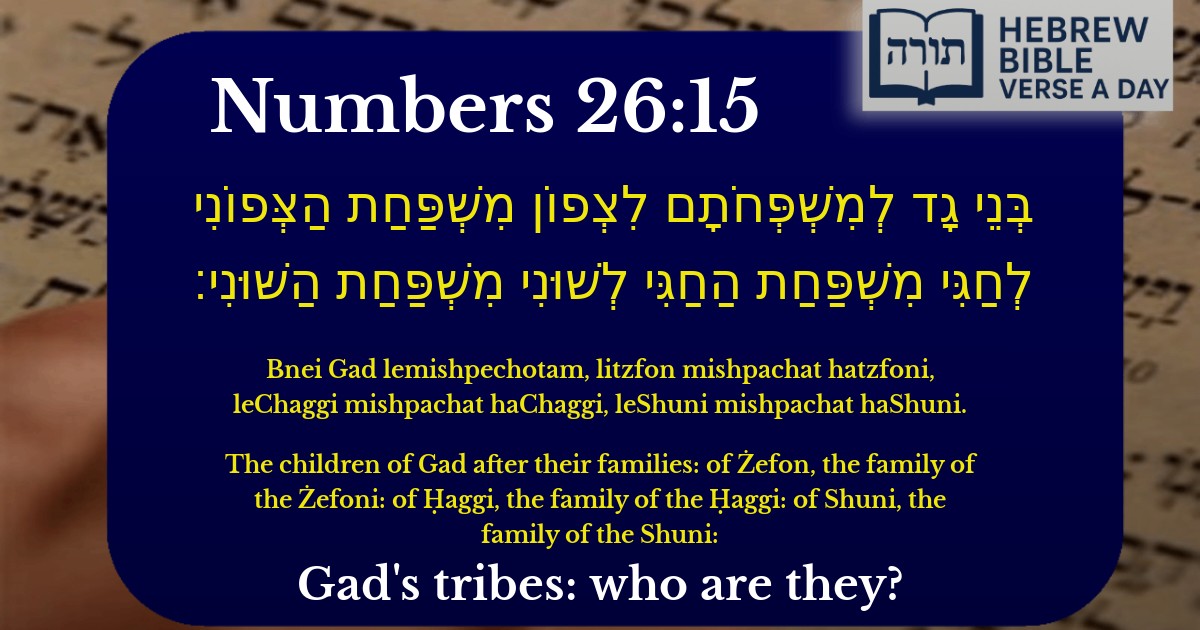Join Our Newsletter To Be Informed When New Videos Are Posted
Join the thousands of fellow Studends who rely on our videos to learn how to read the bible in Hebrew for free!
Hebrew Text
בְּנֵי גָד לְמִשְׁפְּחֹתָם לִצְפוֹן מִשְׁפַּחַת הַצְּפוֹנִי לְחַגִּי מִשְׁפַּחַת הַחַגִּי לְשׁוּנִי מִשְׁפַּחַת הַשּׁוּנִי׃
English Translation
The children of Gad after their families: of Żefon, the family of the Żefoni: of Ḥaggi, the family of the Ḥaggi: of Shuni, the family of the Shuni:
Transliteration
Bnei Gad lemishpechotam, litzfon mishpachat hatzfoni, leChaggi mishpachat haChaggi, leShuni mishpachat haShuni.
Hebrew Leining Text
בְּנֵ֣י גָד֮ לְמִשְׁפְּחֹתָם֒ לִצְפ֗וֹן מִשְׁפַּ֙חַת֙ הַצְּפוֹנִ֔י לְחַגִּ֕י מִשְׁפַּ֖חַת הַֽחַגִּ֑י לְשׁוּנִ֕י מִשְׁפַּ֖חַת הַשּׁוּנִֽי׃
Parasha Commentary
📚 Talmud Citations
This verse is not quoted in the Talmud.


Overview of the Verse
The verse (Bamidbar 26:15) lists the families of the tribe of Gad, specifically mentioning the descendants of Zefon, Chaggi, and Shuni. This enumeration appears in the census taken in the plains of Moav before Bnei Yisrael entered Eretz Yisrael. The structure follows the pattern of other tribal genealogies in the parsha, emphasizing the importance of lineage and family identity within the nation.
Rashi's Commentary
Rashi (Rabbi Shlomo Yitzchaki) notes that the names of these families correspond to the sons of Gad mentioned earlier in Bereishit 46:16. He explains that the repetition here serves to reinforce the continuity of the tribes and their subdivisions, ensuring clarity in inheritance and tribal affiliation when dividing the land.
Significance of Family Lineage
According to Rambam (Maimonides) in Hilchot Nachalot, the meticulous recording of family names was essential for:
Midrashic Insights
The Midrash (Bamidbar Rabbah) connects the names of Gad's families to their characteristics:
Halachic Implications
The Sifrei emphasizes that these genealogical records were necessary for:
Contemporary Relevance
Rabbi Samson Raphael Hirsch explains that this detailed accounting teaches the importance of recognizing individual family units within the broader Jewish nation. Each family contributes unique qualities to Klal Yisrael while maintaining their distinct identity, much like different instruments in an orchestra creating harmonious unity.